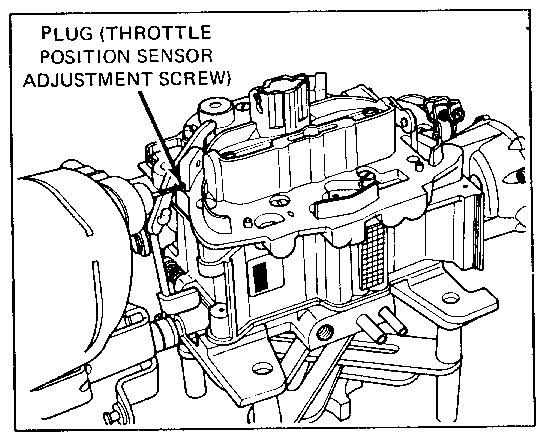THROTTLE POSITION SENSOR ADJUSMENT (CCC VEHICLES)

A revised Throttle Position Sensor (TPS) adjustment procedure has been developed for 1981 4.1 liter V-6 equipped vehicles. TPS adjustment may be required when following the diagnostic procedures for trouble code 21, Throttle Position Sensor Circuit.
1. Remove air cleaner and check curb idle speed per emissions specifications label and adjust if necessary. Shut off ignition.
2. Disconnect sensor harness from Throttle Position Sensor and reconnect with three jumper wires to re-establish the same electrical continuity.
3. Connect a high impedance digital voltmeter (such as J-29125) to the center terminal (B) and bottom terminal (C).
4. With ignition on, engine not running and throttle properly adjusted for correct curb idle, measure voltage between terminals B and C. If a reading of .56V is obtained, sensor is properly adjusted. If a reading of other than .56V is obtained, proceed to step 5 for TPS adjustment.
5. The TPS adjustment screw is covered by a tamper resistant plug. To remove the plug, use a No. 48 (.076") drill and drill out the center of aluminum plug approximately 1/16" to 1/8" (refer to figure below).
6. Start a No. 8-1/2" long self-tapping screw into drilled hole. Turn the screw only enough to ensure good thread engagement in hole.
7. Place blade section of a wide screwdriver between screw head and air horn casting and pry against screw head to remove plug.
8. Using tool J-28696 or equivalent, remove adjusting screw. Apply thread-lock adhesive (Delco kit No. X-10 or equivalent) to threads and reinstall.
9. Before thread lock adhesive has time to cure, adjust sensor to .56V by turning TPS adjusting screw. The same procedure used in step 4 to measure TPS voltage should be followed.
10. Remove voltmeter, jumper wires, reinstall TPS connector and install air cleaner.

General Motors bulletins are intended for use by professional technicians, not a "do-it-yourselfer". They are written to inform those technicians of conditions that may occur on some vehicles, or to provide information that could assist in the proper service of a vehicle. Properly trained technicians have the equipment, tools, safety instructions and know-how to do a job properly and safely. If a condition is described, do not assume that the bulletin applies to your vehicle, or that your vehicle will have that condition. See a General Motors dealer servicing your brand of General Motors vehicle for information on whether your vehicle may benefit from the information.
